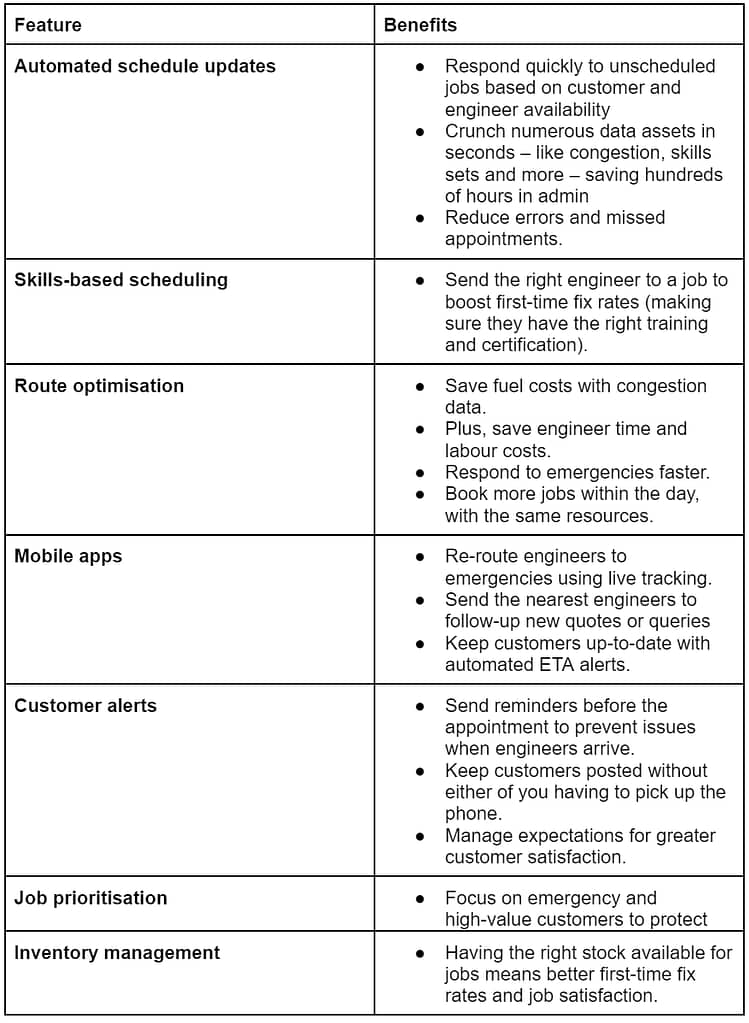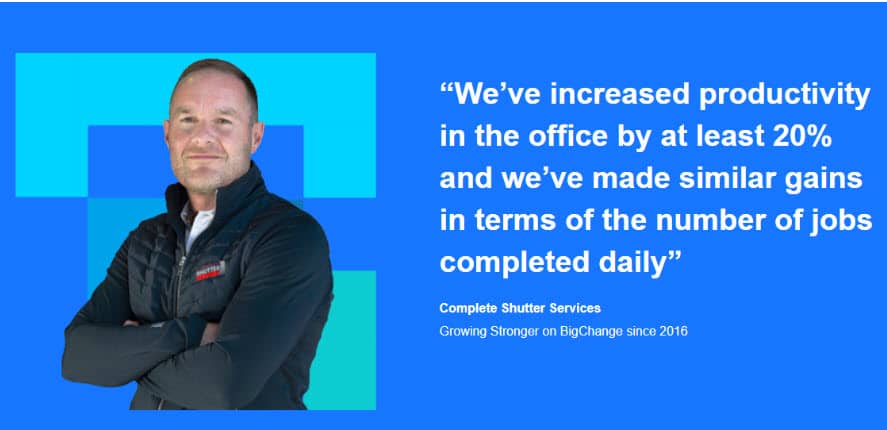> The buyer’s guide to job scheduling software in 2024
Stock shortages. Last-minute scheduling changes. Missed appointments. Lost productivity.
You may have accepted these as inevitable hiccups involved in running a field service business. But, it doesn’t need to be like that… What if there was a solution that helped you gain greater control of the chaos?
Enter: job scheduling software ⚡
Job scheduling software is designed specifically to make coordinating, managing and optimising work schedules much simpler and faster – all thanks to clever tech like integrations with GPS, automated skills-matching and real-time reporting.
But, there’s more to it than that.
In 2024, there are additional things to keep an eye out for if you want your business to grow.
That’s where this buyer’s guide comes in. 📕 We’ll talk you through:
- Job scheduling software: Cost savings and ROI
- Must-have features in any job scheduling software
- Buying considerations to shortlist job scheduling software
- Job scheduling software: What to look for in 2024
- Maximise operations with the right job scheduling software
Let’s dive straight in. 🤿
JOB SCHEDULING SOFTWARE: COST SAVINGS AND ROI
Let’s be brutally honest here. The main priority is making sure the tech delivers a return on investment. But, not all job scheduling software is made equal. And they don’t all deliver ROI. It’s also important to weigh up your long-term goals. If growth is your ambition in 2024, you need tech that can grow with you – while being cost-effective.
PRICING MODELS 💸
Different suppliers have different pricing options – which can make it a little tricky to compare:
- Subscription-based: Billed monthly, or annually, these subscriptions tend to combine the number of users and/or the features included to generate a fee.
- Per-user: Some will charge purely based on the number of users. It’s a great option for smaller teams but can be pricey as your business grows.
- Feature-based: This job scheduling software costs more for the more advanced features.
- Custom-pricing: For enterprise businesses, most job scheduling software providers will request you get in touch for bespoke pricing. This is so they can tailor it to specific needs.
Now, when it comes to being cost-effective, you need to be able to assess how the tech actually improves operations. For example:
✅How it saves administrative time scheduling, reduces engineers’ travel time, and increases job completion rates.
✅How it directly reduces costs like fuel consumption and overtime wages.
✅How it supports revenue increases by allowing you to complete more jobs per day and gain repeat business through better service delivery.
✅How it allows you to spot upcoming trends with real-time reporting functionality so that you seize growth opportunities.
It’s quite a lot to compute.
In fact, we’ve actually written an entire blog on this one. 👇
And, we’ve got this simple ROI calculator that’s powered by an algorithm that figures all this out for you:

To sum this all up, you want to look for a solution that provides efficient job scheduling right now but also scales with you. And the cheapest option may not be the best over the long-term.
Heads up: Free trials are great but obscure trial dates can tie you into a product you may not want, sometimes you get auto-subscribed to the top package and a lot of free trials won’t give full access to the system.
Ultimately, it’s about finding a solution that’s the best value for your needs. This is where our next section comes in.
MUST-HAVE FEATURES IN ANY JOB SCHEDULING SOFTWARE
Job scheduling software needs to act as a central system for all your resourcing and customer needs. These are the essential features leading field service businesses look for:

On top of these basic features, there are additional factors to consider before purchasing or switching job scheduling software.
BUYING CONSIDERATIONS TO SHORTLIST JOB SCHEDULING SOFTWARE
We’ve already touched on future-proofing your business. Basically, there are five key considerations to help you do just this:
#1: CLOUD VS ON-PREMISE ☁
Cloud-based tech is more flexible and is often the only way to give field engineers’ the mobile functionality they need. You aren’t tied down like with local networks so you can work from anywhere. Plus, it’s regularly and automatically updated.
#2: IMPLEMENTATION AND TRAINING 🎓
Don’t get suckered by a great sales pitch. Look for providers that will give thorough onboarding training, get you set up quickly – and provide additional support post-implementation.
#3: DATA MIGRATION ⚙
Some providers will even provide data support services to ensure no historical job information and customer data is lost.
#4: NEW FEATURES AND MAINTENANCE 🛠
Look for providers that are always-on it with product development based on new needs and the latest tech innovations.
#5: SCALABILITY 📈
As we’ve touched on in pricing, look for software that can handle your projected growth – but without incremental licensing fees. Essentially, you want job scheduling software that meets your needs today and helps in the future.
Now we’ve covered the basics, there’s something a little more exciting to delve into.
JOB SCHEDULING SOFTWARE: WHAT TO LOOK FOR IN 2024
So, what’s new for 2024? Here’s what you need to look for if you’re serious about growth…
✅ Predictive analytics: To prepare for maintenance needs and inventory requirements.
✅ Real-time updates: For quick decision-making, comprehensive tracking of profit and forecasts, and instant updates to engineers LIVE.
✅ Fully customisable apps: Don’t accept off-the-shelf. The tech needs to meet your needs.
✅ Integrations: Job scheduling software can only automate and track operations if your other systems feed into it.
✅ Security and compliance: This will continue to be a concern for you, and your clients – thanks to increasing cyberattacks, and costly data breaches. As a minimum, you need tech that’s got:
- Two-Factor Authentication (2FA)
- End-to-End Encryption
- Secure Data Storage
- Regular Software Updates
- Role-Based Access Control
✅ Sustainability: Reducing carbon footprint through route optimisation and resource planning supports sustainability objectives.
The power of automation and smart technology is really what allows field services to grow. But the tech also needs to tick the boxes of compliance and sustainability too, to meet both your business and clients’ additional needs.
MAXIMISE OPERATIONS WITH THE RIGHT JOB SCHEDULING SOFTWARE
Choosing the right job scheduling software is a big decision. Not only does it make job scheduling much smoother, it creates the foundations for future growth. And those already using it have seen it directly impact their bottom line.
Like these examples:
- $1.5m boost to business growth – Eurotech Environmental
- 20% increase in workforce productivity – A&S Contractors
- 25% increase in customer service rating – Heatforce

By leveraging automation, optimisation tools and having everything easily accessible from a mobile, the entire operations become streamlined and there’s greater visibility to spot opportunities and areas of weakness.
More jobs get completed without wasting time or fuel. And emergencies or unexpected changes can quickly be catered for to protect your profit margins.
It’s all about efficiency and flexibility.
On top of this, it’s a big win for customer satisfaction. Customers know exactly when an engineer will be with them.Looking to transform operations today? Book in for a demo and we’ll talk through how we can cater to your unique needs – and save a tonne of money.

